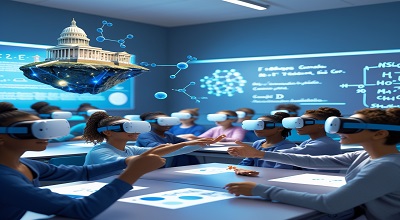Virtual Reality Classroom Simulations
Virtual Reality Classroom Simulations (VR) have transitioned from a futuristic concept to a transformative tool in modern education. By immersing students in interactive 3d environments, VR offers experiences that traditional classrooms cannot replicate. This article delves into the latest VR classroom simulations, highlighting their applications, benefits, and real-world examples.
Understanding VR Classroom Simulations
VR classroom simulations are digital environments where students can engage in realistic scenarios using VR headsets. These simulations range from historical explorations to scientific experiments, providing an experiential learning approach that enhances understanding and retention.
Key Benefits of VR in Education
- Enhanced Engagement: Immersive environments captivate students, making learning more engaging.
- Safe Experimentation: Students can conduct experiments and explore scenarios without real-world risks.
- Accessibility: VR can bring distant or inaccessible locations into the classroom.
- Personalized Learning: Tailored simulations cater to diverse learning styles and paces.
Real-World Applications of VR Simulations
- Historical Reenactments: Students can witness historical events firsthand, deepening their understanding of history.
- Scientific Exploration: Virtual labs allow students to conduct experiments and explore scientific concepts interactively.
- Medical Training: Medical students can practice procedures and diagnose conditions in a risk-free virtual environment.
- Language Learning: Immersive environments help students practice new languages in context-rich settings.
Examples of VR Classroom Simulations
- Mindflight7 (Australia): This platform offers VR experiences across various subjects, allowing students to explore environments like rainforests or historical events.
- TALIA by UNSW: A tool that enables educators to create virtual field trips, providing students with experiences like visiting Mars or exploring a hospital emergency room.
- St. John’s University Health Sciences Center: Equipped with lifelike mannequins and VR setups, this center allows medical students to practice procedures and diagnose conditions in a controlled environment.
Implementing VR in the Classroom
To integrate VR into education:
- Select Appropriate Hardware: Choose VR headsets that are compatible with educational content.
- Develop or Acquire Content: Utilize platforms that offer educational VR simulations or develop custom content.
- Train Educators: Provide training for teachers to effectively incorporate VR into their teaching methods.
- Ensure Accessibility: Consider the needs of all students, ensuring that VR experiences are inclusive.
Challenges and Considerations
While VR offers numerous benefits, there are challenges to consider:
- Cost: High-quality VR equipment and content can be expensive.
- Technical Issues: Compatibility and maintenance of VR systems can pose challenges.
- Health Concerns: Prolonged use of VR headsets may cause discomfort or health issues for some students.
- Content Quality: The effectiveness of VR simulations depends on the quality and relevance of the content.
The Future of VR in Education
The future of VR in education looks promising:
- Advancements in Technology: Continuous improvements in VR hardware and software will enhance the learning experience.
- Wider Adoption: As costs decrease, more institutions will integrate VR into their curricula.
- Collaborative Learning: VR can facilitate collaborative learning experiences, connecting students across the globe.
- Lifelong Learning: VR can support continuous education and professional development through immersive simulations.
Conclusion
VR classroom simulations are revolutionising education by providing immersive, interactive learning experiences. As technology advances and adoption increases, VR has the potential to transform traditional education, making learning more engaging, accessible, and effective.
Frequently Asked Questions (FAQs)
The future includes advancements in technology, wider adoption, collaborative learning opportunities, and support for lifelong learning.
What is VR classroom simulation?
It’s a digital environment where students can engage in interactive scenarios using VR headsets, enhancing experiential learning.
What are the benefits of using VR in education?
Benefits include enhanced engagement, safe experimentation, accessibility to distant locations, and personalized learning experiences.
Can VR simulations be used in all subjects?
Yes, VR can be applied across various subjects, including history, science, medicine, and language learning.
What are some challenges of implementing VR in classrooms?
Challenges include high costs, technical issues, potential health concerns, and ensuring content quality.
What does the future hold for VR in education?
Free Download: Battle of Warships MOD APK
